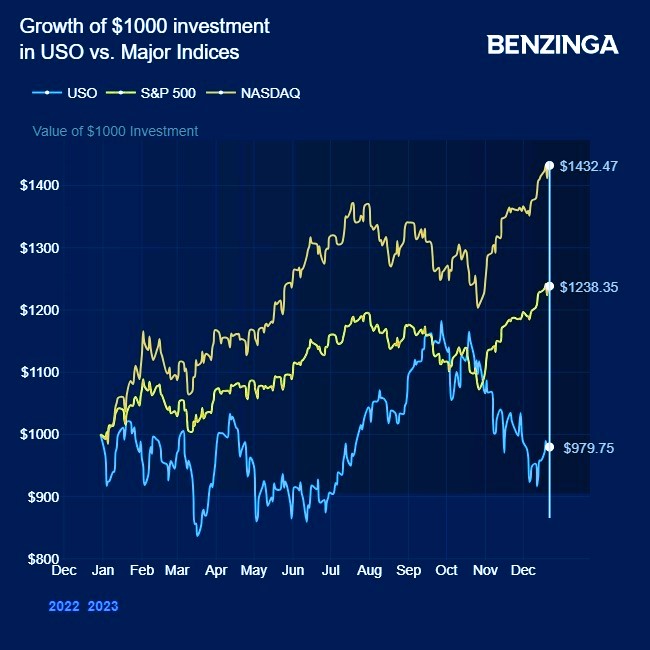Zinger Key Points
- After 2022's modest 3.7% gain, crude oil saw significant volatility this year and traded in a range of sub-$65 level to $90+.
- Record U.S. crude oil production has served to mitigate the impact of OPEC+ production cuts this year.
- China’s new tariffs just reignited the same market patterns that led to triple- and quadruple-digit wins for Matt Maley. Get the next trade alert free.
Crude oil faced a challenging trajectory in 2023, lagging behind various financial assets, and is on track to end the year in the red. Despite robust demand sustained by the global economy’s resilience in the face of inflation and high interest rates, oil struggled to maintain its momentum.
OPEC Cuts Ineffective: The West Texas Intermediate (WTI) grade, known for its lower sulfur content, began the year with a modest 3.7% gain, only to grapple with a turbulent journey throughout.
Crude oil’s trajectory was uneven through the COVID-19 years, pulling back by 21% in 2020 followed by a strong 51% rebound in 2021. However, 2023 told a different story.
Starting this year at $80.18, WTI witnessed volatility in the first half, surging above $90 in September before reversing course. Currently, it’s trading down about 8% for the year.
The United States Oil Fund, LP USO, which tracks WTI crude oil, reflects this trend, showing a 1.1% year-to-date loss.

Chart Courtesy of Benzinga
The price weakness has come despite some of the members of the OPEC+ oil coalition persisting with their voluntary production cuts and talking up the commodity. Saudi Arabia, a major member of OPEC+, and a few other member countries began cutting oil production in May after the commodity fell below the psychological resistance of $65 in late March.
A collective output cut of 1.66 million bpd by nine OPEC+ nations was later deepened to 2.2 million bpd in late November, according to data provided by the U.S. Energy Information Administration.
OPEC’s monthly oil production has fallen from a near-term peak just under 30 million bpd in September 2022, according to data provided by the U.S. Energy Information Administration.

Source: EIA
Data provided by the International Energy Agency in its December monthly oil market report show that the production target of OPEC+ members for November was 50.46 million bpd, comprising 36.92 million bpd from OPEC members and 13.54 million bpd from the non-OPEC allies.
See Also: Best Commodities To Buy
America, The New OPEC? Challenging OPEC’s traditional dominance, the U.S. achieved a potential new record in annual crude oil production in 2023, OilPrice.com reported, citing the latest weekly production figure reported by the EIA. This was facilitated by robust contributions from oil shale, efficiency measures, and industry consolidation, with major deals like Chevron Corp‘s CVX $53-billion acquisition of Hess Corp. HES, and Exxon Mobil Corp‘s XOM $60-billion purchase of Pioneer Natural Resources Company PXD.
The U.S. oil industry’s record output has effectively countered OPEC’s attempts to elevate oil prices, a Wall Street Journal report said in July. The Energy Information Administration estimates global oil production at 101.62 million bpd in 2023 and 102.19 million bpd in 2024, with consumption projections at 101 million bpd and 102.34 million bpd, respectively.
Energy Market Outlook: The Energy Information Administration offers a positive outlook for oil in 2024, anticipating a soft landing for the global economy and potential Federal Reserve rate cuts.
Geopolitical tensions in oil-producing regions, like East Europe, may also contribute to oil’s resilience.
Fund manager Louis Navellier forecasts oil breaching $100 a barrel, with potential disruptions, including another pipeline incident in Russia, continued Red Sea attacks, and aggression against Guyana by Venezuela, acting as upside catalysts.
He recommends holding energy stocks as they are an “oasis and a hedge to protect investors.”
“Furthermore, energy stocks will have much easier year-over-year comparisons for the next three quarters,” he added.
Wall Street analysts offer a more conservative average estimate of $85 for Brent crude, currently trading at around $79.50.
The USO ended Wednesday’s session down 1.84% at $68.92, according to data from Benzinga Pro.
Read Next: Best Commodity ETFs
Edge Rankings
Price Trend
© 2025 Benzinga.com. Benzinga does not provide investment advice. All rights reserved.
Trade confidently with insights and alerts from analyst ratings, free reports and breaking news that affects the stocks you care about.